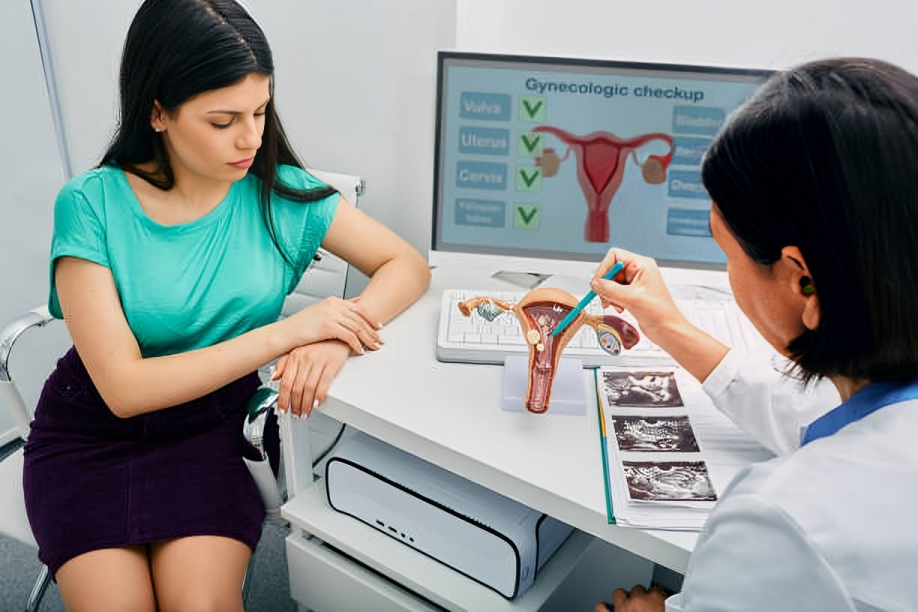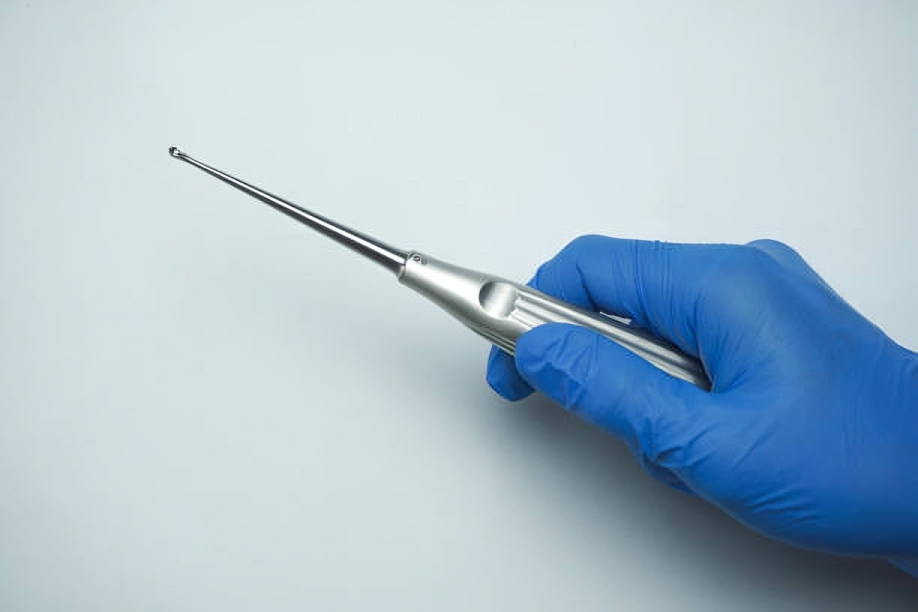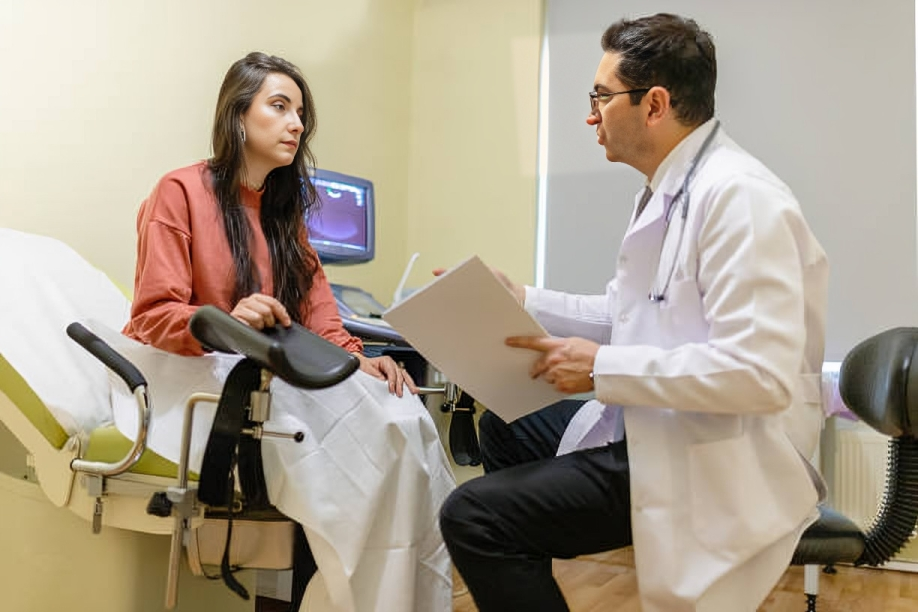Endocervical Curettage is a sampling procedure that diagnoses cervical issues by scraping the mucous membrane of the cervix. It is part of a broader cervical evaluation to check the lining of your cervix for any abnormalities, especially cancerous and precancerous lesions.
What is Endocervical Curettage?
The term endocervical curettage literally means scraping the inner lining of the cervix. It uses a small, metallic spoon-like surgical instrument called a curette. It is performed after colposcopy, which is the close examination of your cervix under a light source.1NCI Dictionary of Cancer Terms. (2024). National Cancer Institute; Cancer.gov. https://www.cancer.gov/publications/dictionaries/cancer-terms/def/endocervical-curettage
Only a skilled doctor or colposcopist can perform this procedure. It can confirm the presence of abnormal cells in your cervical lining after suspicious results on a pap smear and regular colposcopy.
In the United States, curettage is mostly carried out when you are conscious and is not performed under the influence of general anesthesia.
Indications of Endocervical Curettage
The cervix is an internal organ; we cannot view it with the naked eye. Even colposcopy can miss lesions sometimes as it cannot show the cells of the cervix. This means that your doctor needs to perform additional procedures to rule out any cervical abnormality and to detect cervical cancer before it becomes advanced. This is why this procedure is used to check for lesions in the cervix.2van, Rodriguez, A., Marta del Pino, Romy van Baars, Jenkins, D., van, Aureli Torne, Jaume Ordi, Bram ter Harmsel, Rene, Schiffman, M., Gage, J. C., Quint, V., & Wentzensen, N. (2015). The Value of Endocervical Curettage in Addition to Biopsies in Women Referred to Colposcopy. Journal of Lower Genital Tract Disease, 19(4), 282–287. https://doi.org/10.1097/lgt.0000000000000124
Cervical Malignancy
Precancerous lesions in the cervix stay asymptomatic till they become cancerous. Even the early stages of cancer don’t cause symptoms in most cases. Advanced cervical cancer causes various signs and symptoms, which are indications of colposcopy and endocervical curettage:
- Abnormal vaginal discharge
- Pelvic pain
- Vaginal bleeding after sex
- Postmenopausal vaginal bleeding
- Lower back pain
- Unexplained weight loss3Shepherd, J. P., Guido, R., & Lowder, J. L. (2014). Should Endocervical Curettage Routinely Be Performed at the Time of Colposcopy? A Cost-Effectiveness Analysis. Journal of Lower Genital Tract Disease, 18(2), 101–108. https://doi.org/10.1097/lgt.0b013e3182a0b572
After Abnormal Test Results
Given the silent nature of cervical disorders, your doctor will recommend you undergo regular screening tests such as Pap smears. If there are any abnormal cells, they will recommend you undergo a colposcopy.
If there is suspicion of any abnormality, the doctor will perform a colposcopy after an endocervical curettage to confirm the presence of suspicious lesions in your cervix.
How can you prepare for Endocervical Curettage?
This procedure is performed at colposcopic units in hospitals and women’s health clinics. Before the procedure, the doctor will fully examine you and tell you to avoid a few things in preparation for curettage.
History & Examination:
Your doctor will take a thorough history of any abdominal and pelvic complaints you have. They will ask questions such as:
- Have you been having any unprotected sexual activity? Have you been vaccinated against HPV?
- When did you last have your period? Have you noticed any changes in the blood flow and pain that wasn’t there before?
- Do you experience any pain and discomfort during sex and while inserting tampons?
- Have you been noticing a change in your vaginal discharge? Is it the same in terms of amount, odor, and appearance?
They will also inquire about your allergies to ensure you are not allergic to the materials used in endocervical curettage.

Informed consent:
The doctor will explain the details of this procedure to you to obtain your consent. The doctor will also inform you about the steps and accompanying risks of the procedure. You will need to sign a document as proof of your informed consent.
What to avoid before Endocervical Curettage?
You should avoid a few activities two to three days before the procedure:
- Vaginal intercourse
- Inserting anything into your vagina
- Vaginal creams
- Vaginal douching
If the doctor decides to put you under general anesthesia (if indicated), you will also be asked to avoid eating and drinking for a few hours before the procedure.
Step-by-Step Procedure
Preparation for the Procedure:
During the preparations for endoscopic curettage, you will be sent to the colposcopic unit of the hospital or women’s health clinic. You will be requested to wear a sterile gown, and a healthcare professional will help you get in the right position for the procedure.
Positioning of the Patient:
For this procedure, you will lie in a modified lithotomy position. In this position, you lie on your back on an exam table with both your hips flexed and knees bent. Your doctor will place your legs in stirrups to support them and have a clear view of your genital area to perform the procedure.

Professionals have long been debating the use of anesthesia and its effectiveness in giving you a painless endocervical curettage experience. This is because the cervix is a part of the body that lacks receptors for pain, though you may experience discomfort and stretching as the doctor will perform this procedure.4Mattar, O. M., Samy, A., Shehata, M., Ibrahim, A. M., Abdelaziz, A., Nesrine Abdelazeim, Elzemrany, A. A., Kasem, S. A., Mohamed Hassan Ros, Hamad, L. Y., Taher, A., El-Sharkawy, M., Mahmoud, M., & Abbas, A. M. (2019). The efficacy of local anesthetics in pain relief during colposcopic-guided biopsy: A systematic review and meta-analysis of randomized controlled trials. European Journal of Obstetrics, Gynecology, and Reproductive Biology/European Journal of Obstetrics & Gynecology and Reproductive Biology, 237, 189–197. https://doi.org/10.1016/j.ejogrb.2019.04.047
Anesthesia:
In the United States, most doctors perform this procedure without any anesthesia at all. Moreover, local anesthesia, such as lidocaine and bupivacaine, only numbs a small part of the body, so some doctors use it during curettage.
Therefore, only one-fifth of all procedures occur with general anesthesia, which includes making the patient fall unconscious for a short period. The drugs used for this include:
- Propofol
- Thiopental
- Etomidate
- Benzodiazepines
Antibiotic Prophylaxis:
As with all surgical procedures, there is a small risk of infection with endocervical curettage. Additionally, the doctor will prescribe antibiotics to avoid this complication.
Procedure:
This procedure follows a standard colposcopy procedure.
- The doctor applies an antiseptic liquid, like an iodine solution, to clean your cervix.
- They gently insert a curette into your cervix and rotate it while scraping off parts of its walls.
- Once the samples have been collected, they slowly pull the curette out.
- In case of minor trauma and bleeding, the area is cleaned with a cotton swab and observed.
- After the procedure, the doctor may apply a soothing agent to your cervix to reduce discomfort. You can go home after the treatment.
If the results show ambiguity, the doctor may conduct a different procedure, known as an excision cervical biopsy, to take a larger sample for examination.5Stewart Massad, Perkins, R. B., Naresh, A., Nelson, E. L., Spiryda, L., Gecsi, K. S., Elie Mulhem, Kostas-Polston, E., Zou, T., Tashima Lambert Giles, & Wentzensen, N. (2022). Colposcopy Standards: Guidelines for Endocervical Curettage at Colposcopy. Journal of Lower Genital Tract Disease, 27(1), 97–101. https://doi.org/10.1097/lgt.0000000000000710
Contraindications of Endocervical Curettage
There are a few contraindications for cervical curettage; these include:
- Pregnancy is an absolute contraindication of endocervical curettage. It may lead to preterm labor and loss of pregnancy.
- PID (pelvic inflammatory disease)
- Genitourinary tract infections (the curette can cause it to spread to the other pelvic organs)
- Menstrual bleeding
- Comatose patient
- Patient allergic to latex, iodine, or acetic acid
- Unconsented patient
- Patients allergic to or intolerant of anesthesia
Side Effects & Complications
This procedure has minimal side effects. It has no long-term complications and does not cause infertility.
- As the lining of your is being scraped off, you can experience some pain and discomfort, especially if the doctor applies too much pressure and after the anesthesia has weaned off.
- The curette may cause damage and scarring to the cervix in case of mishandling.
- There is a risk of bleeding, which may increase if you have a bleeding disorder or if the doctor uses an improper technique.
- You may develop infection if sterility is not maintained.
Most of these issues depend on how the doctor has performed the procedure, not the endocervical curettage itself. Do not let anything deter you from having this procedure if your doctor has recommended you undergo the sampling process.6Cervical Biopsy. (2019, November 19). Hopkinsmedicine.org. https://www.hopkinsmedicine.org/health/treatment-tests-and-therapies/cervical-biopsy
Interpretation of Endocervical Curettage Results
The results of the endocervical curettage procedure show whether or not you have a precancerous or cancerous growth in your cervix. Because its findings can change your entire management plan, it’s important to get it performed by a skilled doctor.
Negative Endocervical Curettage Results
Negative endocervical curettage results imply that no abnormality was present in the scrapings of your cervix. However, depending on the area of the cervix and the doctor’s handling of the curette, you can sometimes get a false negative result.
Positive Endocervical Curettage Results
Positive endocervical curettage results mean the doctor found abnormalities in the samples taken from your cervical lining. Depending on severity, precancerous lesions of the cervix are classified as:
- Cervical intraepithelial neoplasia grade 1 (CIN1)
- Cervical intraepithelial neoplasia grade 2 (CIN2)
- Cervical intraepithelial neoplasia grade 3 (CIN3)

Endocervical curettage helps identify CIN2 lesions even when colposcopy cannot find any evidence of abnormality. Early detection leads to prompt treatment. This way, you can avoid getting cervical cancer, the third most common cancer in women.
Though colposcopy usually detects lesions that have become cancerous, endocervical curettage can confirm them, too.7Wei, B., Li, Q., Seery, S., Qiao, Y., & Jiang, Y. (2023). Endocervical curettage for diagnosing high-grade squamous intraepithelial lesions or worse in women with type 3 transformation zone lesions: a retrospective, observational study. BMC Women’s Health, 23(1). https://doi.org/10.1186/s12905-023-02297-0
Uncertain Endocervical Curettage Results
Uncertain endocervical curettage results show ambiguity. It can be because of improper technique or contamination of the samples.
This means that the procedure either needs to be repeated or that your doctor should do a more invasive biopsy for the confirmation of a precancerous or cancerous lesion.
When will I recover after Curettage?
Endocervical procedures carry little risk, and you can return to your routine life. However, it is best to take a day or two off to help your body recover and avoid experiencing any pain.
Sex after Endocervical Curettage
You are advised to avoid sex for a few days after endocervical curettage. Your genital tract needs time to recover. Penetrative vaginal sex can cause additional trauma or prevent the lining of the cervix from healing fast.
Pregnancy after Endocervical Curettage
This procedure is only contraindicated in ongoing pregnancy because of the risks involved. It does not affect future conception, and it does not affect fertility. You can try for a baby as soon as you resume sexual activity.
Endocervical Curettage Aftercare
It is normal to experience some pain and discomfort after an endocervical procedure. Your doctor may prescribe a painkiller and/or muscle relaxant to ease the experience. They will ask you to avoid aspirin or any other medication that can increase bleeding.
Avoid inserting any object into your vagina, as this can cause discomfort and increase soreness. This includes tampons, creams, and sexual objects. You do not need to take extra measures like herbal ointments and teas, as there is no evidence for their effectiveness in the aftercare of endocervical curettage.
Can I walk after curettage?
After endocervical curettage, you can walk and resume normal activities. However, it’s best to rest your body. You should avoid walking back home and instead take a car ride. Similarly, wait a few days to exercise to avoid overexertion.
Will I bleed after Endocervical Curettage?
After endocervical curettage, you may experience some spotting, but that will subside within a week. If it doesn’t, or if the bleeding is too heavy (more than just spotting, similar to menstruation days with little blood loss), immediately contact your doctor.
When should you see a doctor after Endocervical Curettage?
A doctor usually schedules you for a follow-up after a couple of months. However, you should seek immediate medical help if you experience any of the following:
- Heavy bleeding instead of spotting
- Bleeding that lasts more than a week
- Changes in your vaginal discharge
- Signs of infection like severe pelvic pain, high-grade fever, and chills
Is Endocervical Curettage Painful?
Endocervical curettage can cause mild to moderate pain and discomfort depending on the health of your urogenital tract. It is similar to the pain you experience during menstrual cramps.
Endocervical Curettage Vs. Biopsy
A biopsy is simply the process of taking living cells from an organ and checking it for abnormalities. Endocervical curettage is a sampling biopsy procedure. However, it differs from other cervical biopsies in that there is no excision of the cervical wall. It only involves gentle scraping and is much less invasive.
Endocervical Curettage Vs. Colposcopy
Endocervical curettage involves scraping and collecting samples of the cells of the cervix. Doctors perform it after colposcopy, which involves examining the cervix under a light source to check for abnormalities.
Endocervical Curettage Vs. Colonoscopy
Endocervical curettage helps obtain sample cells from the cervix, whereas colonoscopy can visualize the colon or your large intestines. Both are diagnostic medical procedures for different organs of your body. Endocervical curettage is used to detect the cancer of the cervix, whereas colonoscopy detects the cancer of the colon and rectum.8Massad, L. S., Perkins, R. B., Naresh, A., Nelson, E. L., Spiryda, L., Gecsi, K. S., Mulhem, E., Kostas-Polston, E., Zou, T., Giles, T. L., & Wentzensen, N. (2023). Colposcopy Standards: Guidelines for Endocervical Curettage at Colposcopy. Journal of lower genital tract disease, 27(1), 97–101. https://doi.org/10.1097/LGT.0000000000000710
Conclusion
To conclude, it is a simple, minimally diagnostic sampling procedure that checks the lining of your cervix for any abnormalities. It helps in early cancer detection and can be performed in a few minutes. It is an outpatient procedure; you can go home the same day. You should avoid placing anything in your vagina for a few days after endocervical curettage.
Refrences
- 1NCI Dictionary of Cancer Terms. (2024). National Cancer Institute; Cancer.gov. https://www.cancer.gov/publications/dictionaries/cancer-terms/def/endocervical-curettage
- 2van, Rodriguez, A., Marta del Pino, Romy van Baars, Jenkins, D., van, Aureli Torne, Jaume Ordi, Bram ter Harmsel, Rene, Schiffman, M., Gage, J. C., Quint, V., & Wentzensen, N. (2015). The Value of Endocervical Curettage in Addition to Biopsies in Women Referred to Colposcopy. Journal of Lower Genital Tract Disease, 19(4), 282–287. https://doi.org/10.1097/lgt.0000000000000124
- 3Shepherd, J. P., Guido, R., & Lowder, J. L. (2014). Should Endocervical Curettage Routinely Be Performed at the Time of Colposcopy? A Cost-Effectiveness Analysis. Journal of Lower Genital Tract Disease, 18(2), 101–108. https://doi.org/10.1097/lgt.0b013e3182a0b572
- 4Mattar, O. M., Samy, A., Shehata, M., Ibrahim, A. M., Abdelaziz, A., Nesrine Abdelazeim, Elzemrany, A. A., Kasem, S. A., Mohamed Hassan Ros, Hamad, L. Y., Taher, A., El-Sharkawy, M., Mahmoud, M., & Abbas, A. M. (2019). The efficacy of local anesthetics in pain relief during colposcopic-guided biopsy: A systematic review and meta-analysis of randomized controlled trials. European Journal of Obstetrics, Gynecology, and Reproductive Biology/European Journal of Obstetrics & Gynecology and Reproductive Biology, 237, 189–197. https://doi.org/10.1016/j.ejogrb.2019.04.047
- 5Stewart Massad, Perkins, R. B., Naresh, A., Nelson, E. L., Spiryda, L., Gecsi, K. S., Elie Mulhem, Kostas-Polston, E., Zou, T., Tashima Lambert Giles, & Wentzensen, N. (2022). Colposcopy Standards: Guidelines for Endocervical Curettage at Colposcopy. Journal of Lower Genital Tract Disease, 27(1), 97–101. https://doi.org/10.1097/lgt.0000000000000710
- 6Cervical Biopsy. (2019, November 19). Hopkinsmedicine.org. https://www.hopkinsmedicine.org/health/treatment-tests-and-therapies/cervical-biopsy
- 7Wei, B., Li, Q., Seery, S., Qiao, Y., & Jiang, Y. (2023). Endocervical curettage for diagnosing high-grade squamous intraepithelial lesions or worse in women with type 3 transformation zone lesions: a retrospective, observational study. BMC Women’s Health, 23(1). https://doi.org/10.1186/s12905-023-02297-0
- 8Massad, L. S., Perkins, R. B., Naresh, A., Nelson, E. L., Spiryda, L., Gecsi, K. S., Mulhem, E., Kostas-Polston, E., Zou, T., Giles, T. L., & Wentzensen, N. (2023). Colposcopy Standards: Guidelines for Endocervical Curettage at Colposcopy. Journal of lower genital tract disease, 27(1), 97–101. https://doi.org/10.1097/LGT.0000000000000710

